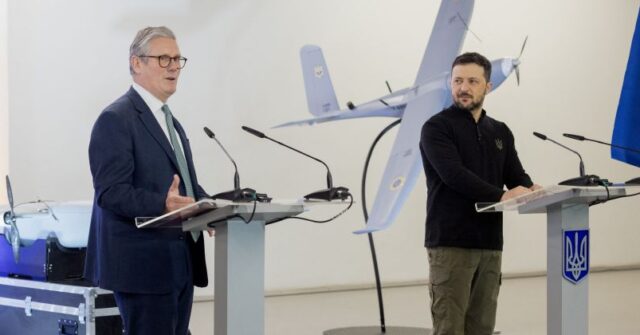Ukraine is to receive a new shipping container-sized “mobile air defence capability” this year, The United Kingdom announced as Prime Minister Sir Keir Starmer made the first visit of his now six month-old leadership to Kyiv on Thursday.
The main headline-catching exercise of the trip was Starmer making a surprise announcement of a 100-year treaty with Ukraine, an agreement being signed with President Volodymyr Zelensky yesterday. The content of the treaty is to be debated in Britain’s Parliament in the coming weeks, Downing Street said.
But also announced was a new tranche of cash and support for Ukraine, the British government announcing: “The £4.5 billion boost for Ukraine in 2025 will see the UK will procure hundreds more air defence systems, drones and essential equipment support to sustain Ukrainian forces on the front line.”
Remarkably, among this is to be a novel air defence system called ‘Gravehawk’ developed by a British company for Ukraine. Sir Keir said: “the UK will deliver a new mobile air defence capability to Ukraine this year”.
While little has officially been revealed about shipping container-sized Gravehawk, the UK government’s press release on the system states it has been “rapidly developed to meet Ukrainian needs on the battlefield”, that it is UK designed but jointly funded by Britain and Denmark.
Gravehawk does not appear to be a new missile, but rather a novel — the UK government calls it “innovative” — means to deploy missiles that already exist. It is able to “retrofit air-air missiles for ground-based air defence” and is able to “use Ukrainian missiles already in their Armed Forces’ possession”.
Two prototypes were already tested in Ukraine last year, said London, and 15 production units will be delivered this year.
The British Armed Forces’ own in-house broadcaster BFBS notes “little else is known about the weapons system” and that no images have been officially published, but some defence-orientated publishers have speculated the system may be the same as a so-called “FrankenSAM” spotted on the battlefields of Ukraine as far back as 2023.
Ukraine’s Defence Express website reported in 2023 on the “ersatz” short range air defence system, with an HMT Armoured Closed Cab truck chassis from the UK’s Supacat company carrying British-made ASRAAM (AIM-132) air-to-air missiles. RBC Ukraine meanwhile suggests a likely candidate for the “retrofit” Ukrainian missiles are likely Russian-designed R-73 air-to-air missiles, which have already been the subject of retrofit experiments by Ukraine recently, suggesting there is a large stock of them available and they are being under-utilised in their intended role.
Both of these missiles have the advantage of being relatively self-contained and infrared-guided, meaning they can more or less be pointed at the intended target and fired without much need for complicated ground systems. The range is likely to be very short, however: air-to-air missiles are designed to benefit from being launched at altitude and high air-speed. Ground-launching will mean burning a great deal of fuel to get airborne, reducing the overall range to perhaps just a few miles.
Beyond “FrankenSAM”, several other initiatives have been announced. Among them is a return to indigenous British manufacture of artillery barrels for the first time in decades so they can be supplied to Ukraine, and the development of an officer cadet exchange between Ukraine and the United Kingdom. Per London, this would allow the next generation of Ukraine’s officer class to train at the world-renowned Sandhurst officer school in England, while future British officers will have a chance to travel to Ukraine to learn about fighting Russians first-hand.
Breitbart News
Read the full article .


